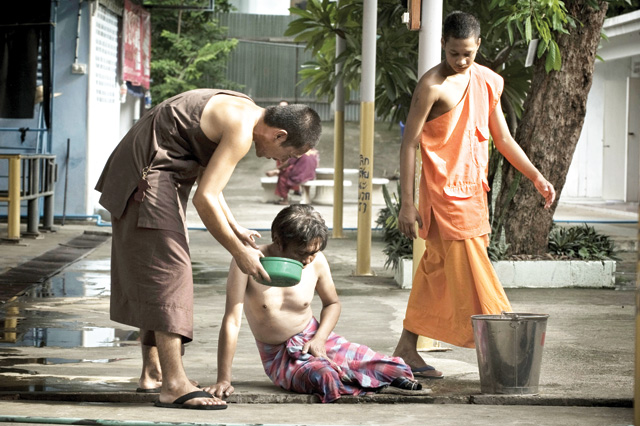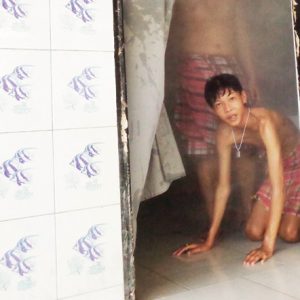The brew simmered in a shot glass. Green as moss. The monk, old and serene, stretched out a boney arm, holding it between thumb and forefinger. Swallowing it, the texture was grainy like the dregs left in a French press. It was skull-splittingly bitter, sour as old milk and burned like a glug of molten plastic.
Immediately the purge started. Saliva welled-up. Grabbing a plastic tub, I began filling it with spit. “Better wait a little before vomiting,” said the monk. He returned to pottering around his alchemist’s shed, uncorking bottles, smelling them and holding some up to the light before nodding and replacing them on shelves brimming with herbal tinctures and concoctions. In between waves of nausea, a strange sense of lightheadedness pervaded.
Purging is part of Wat Thamkrabok’s famous detox program for people addicted to drugs. It is the largest free drug treatment service in Thailand. World famous, even British rock star Pete Doherty came in 2004. Located in between jutting cliffs, 130 kilometres north of Bangkok, this large temple – with its pottery sheds, fields and workshops – feels more like a village than a place of renunciation. At the centre of the compound is an enclosed area known as ‘the Hey’. There, behind wire fences, live the people healing from addiction.

Every day, the Hey’s residents are corralled into wickedly hot steam baths, fed various herbal medicines and taught meditation. They line up in red jumpsuits with the word “winner” emblazoned on the back and vomit into gutters accompanied by ecstatic drumming and singing.
The monks keep meticulous records of the people they detox. According to the current abbot of Thamkrabok, a total of 100,000 people have taken the cure since the temple’s founding in 1957. Today, when they are not casting giant statues from molten rock – the tallest on the compound stands at 41.5m – the monks and nuns chant, tend the gardens or help out in the Hey.
The ingredients of the vomit-inducing brew are a closely guarded secret. “Only one monk knows the recipe,” said John, a former heroin addict from Moscow, who was ordained as a monk last year after finishing treatment himself.
I can’t tell you who it is. All I know is that it has 108 different herbs in it.
John
Staring down into the gutter waiting for the purge to start I noticed decades of vomiting had eroded a twisted pattern in the concrete. “Drink lots of water,” said the herbalist monk. After half a bucket the purge started. The liquid tasted worse on the return journey.
“Keep going,” said the monk, sounding like a tennis coach. “Keep going until all you can taste is water.” After 15 minutes, the vomit ran clear and it was time to stagger over to the herbal steam baths to extirpate any remaining toxins.
The treatment was developed in the 1960s by the monastery’s founder, herbalist and Buddhist nun Mian Parnchand, also known as Luang Paw Yaai. When asked how she came up with the method, the monks mostly shrug and say that she was a holy genius. They believe the medicine mops up the drug toxins and expels them through vomiting. Steam baths amplify the effect.
Reputation has spread by word of mouth.
Vince Cullen
“Over six decades the cure has proven effective,” said Vince Cullen, a former alcoholic who has been helping addicts journey from his native UK to Thamkrabok for 17 years.
Before being allowed to begin the detox, people must take a holy Buddhist vow, known as sajja, to never associate with drugs again. People can choose whether or not to include alcohol in their vow.
“When I first came here I didn’t realise the deepness of the teaching,” said Cullen. “Like a lot of addicts, I saw it as a magic cure, but now I understand it’s 95% sajja.” As well as the vow, addicts are given a personal mantra – a sacred phrase to chant when temptation strikes. “The sajja vow is powerful because it’s not about reluctant abstinence, it’s about wholehearted abandonment,” said Cullen.

For many, wholehearted abandonment is a tall order. “Yesterday I prayed to the Buddha to take this sajja away from me,” said Jose, a charismatic surfer from Costa Rica. “I can’t give up drugs for life; it’s such a long time.” He looked around, angry and lost. “I asked the monk to put me to work tomorrow,” he said. “I’ll do anything, I’m just so bored.” Jose’s trip had been facilitated by Cullen, who had also arranged for him to attend an aftercare programme at the New Life Centre – a mindfulness-based addiction recovery centre in Northern Thailand loosely associated with Thamkrabok.
At the time of my visit, there were about 25 people staying in the rustic dormitories. Beneath the shade of large trees, a cohort of jumpsuit-wearing Thais relaxed. A few more stared at a soap opera on the television. The three foreigners sat apart, separated by the language barrier. The heat of the afternoon stifled everyone’s energy.
Sasha, a Russian monk who was ordained two years ago, sat with the foreigners offering words of encouragement in English. They’re currently miles away from the nearest dealer, with passports and bankcards locked away, but detoxing remains a hazardous activity. “A small proportion of people leave Thamkrabok, relapse and overdose,” said Cullen. ”That’s what convinced me to provide a support service for people after they have gone through treatment here.”
There have been no gold-standard randomised controlled trials on the Thamkrabok treatment, nor has their herbal medicine been analysed, but a pilot study commissioned by East-West detox, a UK-based charity that helps people journey to Thamkrabok, in conjunction with Queen’s University Belfast and Brunel University, of 65 people who undertook the programme found 60% reported being drug-free at a one-year follow-up. “The [medicine] has many active ingredients,” said former consultant psychiatrist Dr Vanessa Crawford via email.
Crawford believes that the monastery handles the needs of the people who come to them for help with their addictions well. Emergency medical aid is available in the nearby town and in Bangkok which is a few hours’ drive away. “All these experiences [at Thamkrabok] and their impact are hard to quantify,” said Crawford. “I know the world wants everything to be evidence-based, but my view is: ‘If it works and the harms are limited, try it.’”
But in many ways I hope no one ever dissects it – the mystery is the power.
Dr Vanessa Crawford
Back at the Hey, the steam bath was fired by a wood-fed furnace with sheathes of lemongrass and morning glory stuffed into its metal arteries. It was nostril-stingingly hot. The addicts filed inside while Sasha stood guard by the flap of rubber that acted as a door. Each attendee wore a small, metal medallion, a reminder of their sajja vow and their intention to change their lives for the better.
The residents exited the baths looking drenched. They sat in rows on the tiled benches cooling their slick brown bodies. Steam curled from their tattoos. “I knew my job in this life was to help people ten years ago when I got sick and almost died,” said Sasha. “When you know what you are meant to do all you need is to wait for the time to be right.”
For him, the time came when he ordained at Thamkrabok. How did the sajja vow help him find his place in life? Sasha paused. “Sajja helps,” he said and fixed me with a calm, authoritative gaze. Strangely, it was all he needed to say.
Because of the stigma associated with addiction some people interviewed declined to give their full names.


